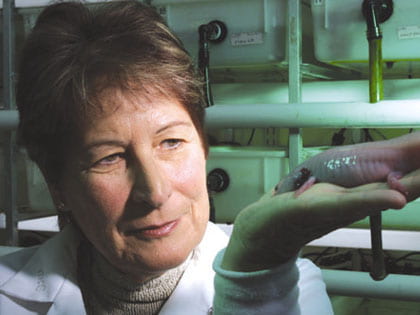Advancing science
When not working on the key to limb regeneration, Susan Bryant aims to involve a new generation of women scientists.

Scenario: A budding pianist loses her right hand in a car accident. Rather than reattach the hand, which would end her career, doctors let the wound heal naturally. They apply a few treatments and in a short time a new identical hand grows in the other’s place.
Science fiction? No, just the future according to Susan Bryant, dean of the School of Biological Sciences.
Now if only getting more women involved in science were as easy as getting people to grow new limbs.
But first, the limbs.
“The human body can regenerate,” says Bryant, who has spent most of her professional career trying to prove this point, in a field of few researchers.
After all, if a salamander can do it, why not a human?
Take the axolotl salamander, native to the lakes around Mexico City and the only lab animal that can regenerate.
“Some researchers try to work with mice to stimulate regeneration,” Bryant says. “I always say, why not look at what can regenerate and find out how that animal is doing it.”
So Bryant focused on the axolotl by analyzing how the salamander perfectly reproduces a missing limb in about one month. For the last two decades, Bryant has been working in collaboration with her partner, David Gardner, a research biologist. Through this collaboration, Bryant is able to remain involved in research while fulfilling her role as dean.
The key to regeneration appears to happen in the first several days after wounding. The salamander starts to grow a new limb in a process that is similar to limb development in an embryo. An embryo starts development from stem cells, which are all the same but have the potential to make any part of the body. As development proceeds, the stem cells become specialized, such as blood and brain cells.
But the axolotl, in order to regenerate, turns this process around. The specialized cells near the wound lose their specialization and become stem cells.
“The salamander makes stem cells to generate a new limb. It does it on the spot and as many times as you want it to,” Bryant says.
“If we could harness that ability, the debate about stem cells would be eliminated. All you would have to do is give a shot of whatever the stimulus agent is, at the site you want to regenerate, and the person’s body would create the stem cells.”
Her research efforts have won high praise from her colleagues, including Bruce Blumberg, assistant professor of developmental and cell biology.
“Dean Bryant’s research is highly innovative,” Blumberg says. “An important characteristic of her work is that she thinks deeply about biological problems, asking difficult questions and refusing to accept explanations that do not account for all of the data.”
In recent years, Bryant and her colleagues have tried to elucidate the molecular basis of limb regeneration and how it is similar to—yet different from—the process of limb development. “Understanding the molecular basis holds enormous promise and could ultimately lead to the development of techniques for regenerating human limbs,” Blumberg says.
“A lot of people think development goes only in one direction,” Bryant says. “Our research shows that’s not true. It’s not that these animals are crawling in stem cells. They have regular cells that, when the right signal comes along, become stem cells.”
Coming up with that signal is the challenge. It’s almost as challenging as finding more women willing to enter scientific fields. And that is Bryant’s second passion.
“Solving the issue of regeneration is only a matter of time and money. I think it’s harder to get women into science,” says Bryant. “It’s hard to break stereotypes. When you close your eyes and imagine a scientist, you don’t get the image of a woman. I think that is true of all the sciences. Tradition influences what you think the future will look like. It’s hard to change cultures.”
But Susan Bryant is more than willing to try. She is the lead administrator for a $3.45 million National Science Foundation ADVANCE grant designed to increase the hiring and retention of women faculty members in science and engineering. UCI has already selected faculty members as equity advisors for the different schools to develop recruiting strategies and lead mentoring and training programs. Successful efforts will become models for institutions nationwide.
“We want to change the way we do business so that the number of women we hire is more reflective of their representation in the field. For example, in biology 45 percent of the Ph.D.s are women, but we have less than 20 percent on faculty.
“To improve in this area, we need to better recognize issues that are important to women candidates—like availability of a position for a partner; an interactive, friendly environment; and on-site day care. Many women also have different negotiation styles and different preferences that must also be addressed.
“By law, we cannot show preference based on gender, and we are not looking at a numerical goal. But since the university will be going through a major growth spurt during the next decade, we hope that about 40 percent of the new junior hires are women. This is not only good for women, but also good for science.
“In any creative enterprise, having diverse points of view leads the way to innovation,” Bryant says. “When you have any area dominated by one type of individual, you cannot get the full spectrum of creativity. As biologists, we know that if you don’t have diversity, you don’t have adaptability, and extinction will inevitably follow.”
